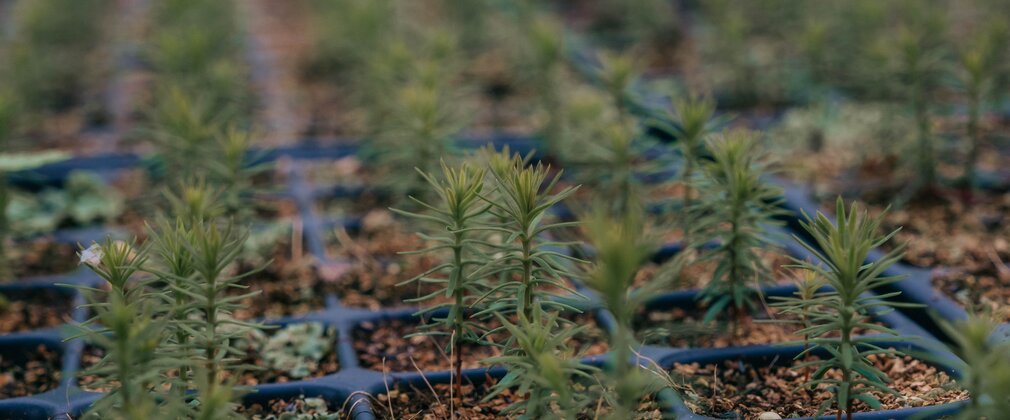
Tuesday 4 November
Forestry England sets out tree species list for the nation’s forests
- 30 priority tree species identified by scientific analysis to future-proof the nation’s forests against climate change and disease
- Species selected for ability to withstand extreme weather, resist pests and diseases and provide commercial timber for decades ahead
- New approach supports wider forest resilience strategy as climate pressures intensify
The nation’s forests, managed by Forestry England, will be made more resilient by planting 30 carefully selected tree species chosen for their ability to survive future climate challenges and disease threats. Forestry England's new tree species for the future list provides a science-based framework to guide tree production and planting decisions across the nation's forests for decades to come.
The list includes familiar and emerging species, each assessed against 10 key criteria including climate suitability, pest resistance and timber potential. This approach addresses the urgent challenge of building forest resilience as the nation’s forests face increasingly extreme weather, climate pressures, and pests and diseases.
Forestry England’s list follows the Future Productive Species list published in September by Scottish Forestry. This set out the 28-strong list of tree species recommended for forestry in Scotland. A similar, sector-wide analysis has been commissioned for England by Defra. Forestry England’s tree species work is separate though complementary to these exercises, and the list has been developed specifically for the 1,500 forests and woodlands in their care.
The final list of 30 species was drawn from a longlist of 63 species and is tailored to Forestry England's six forest districts using local data for regional relevance and national consistency.
Dr Eleanor Tew, Forestry England Head of Forest Planning, said;
“Forest resilience is our most critical challenge. Climate change is already here and affecting the nation’s forests. In the past 18 months we've experienced the wettest winter, hottest spring and hottest summer on record and we're seeing a marked increase in tree pests and disease. Against this backdrop, we need to increase domestic timber production and ensure our forests deliver even more value for society and nature.
“Planting the right tree species is critical, and our tree species for the future list gives our foresters evidence-led guidance to do this. It gives us the confidence to focus our ongoing investment in our plant and seed supply capabilities, so we can produce more of these species ready to plant. By reducing reliance on a few species, and planning strategically for likely future conditions, the nation’s forests will continue delivering value for society, nature and the domestic timber industry.”
This initiative is part of Forestry England's broader forest resilience strategy and action plan, which will be published later this month. This will set out a comprehensive approach to managing the nation’s forests to adapt and thrive, including clear actions on diversifying tree species and forest structures.
Though not prescriptive, Forestry England’s tree species for the future list can be adapted by anyone involved in woodland management across England, with detail on the methodology behind it available on the website.
The tree species included in the list are:
- Aspen (Populus tremula)
- Beech (Fagus sylvatica)
- Coast redwood (Sequoia sempervirens)
- Common alder (Alnus glutinosa)
- Corsican pine (Pinus nigra subsp. laricio)
- Douglas fir (Pseudotsuga menziesii)
- Downy birch (Betula pubescens)
- European silver fir (Abies alba)
- Field maple (Acer campestre)
- Grand fir (Abies grandis)
- Grey alder (Alnus incana)
- Hornbeam (Carpinus betulus)
- Japanese red cedar (Cryptomeria japonica)
- Lodgepole pine (Pinus contorta var. latifolia)
- Macedonian pine (Pinus peuce)
- Maritime pine (Pinus pinaster)
- Norway spruce (Picea abies)
- Pedunculate oak (Quercus robur)
- Red oak (Quercus rubra)
- Rowan (Sorbus aucuparia)
- Scots pine (Pinus sylvestris)
- Sessile oak (Quercus petraea)
- Silver birch (Betula pendula)
- Sitka spruce (Picea sitchensis)
- Sweet chestnut (Castanea sativa)
- Sycamore (Acer pseudoplatanus)
- Western hemlock (Tsuga heterophylla)
- Western red cedar (Thuja plicata)
- Wild cherry (Prunus avium)
- Wild service tree (Sorbus torminalis)
Notes to Editor
- Images are available here. Please note credits on images.
- Forestry England manages and cares for the nation’s 1,500 woods and forests, with over 313 million visits in 2024/25. As England’s largest land manager, we shape landscapes and enhance forests for people to enjoy, wildlife to flourish and businesses to grow. We are continuing the work we have already started to make the nation’s forests resilient to climate change and by 2026 we will:
- create at least 6,000 more hectares where we integrate wilding activities in our productive forests
- increase the diversity of visitors to the nation’s forests and have one million hours of high-quality volunteer time given to the nation’s forests
- plant at least 2,000 hectares of new, high-quality woodlands
For more information visit forestryengland.uk. Forestry England is an agency of the Forestry Commission.
Media contact:
Naomi Fuller, Media Relations Officer | media@forestryengland.uk |
